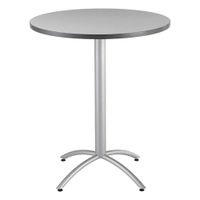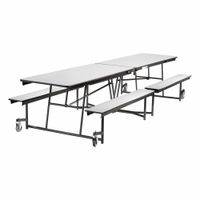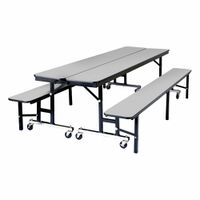Call +(254) 703 030 000 / 751 483 999 / 721 704 777
- Home
- Furnishings Appliances Hospitality
- Furniture
- Cafeteria Dining Breakroom Furniture
Frequently Asked Questions
What are the best materials for cafeteria tables?
The best materials for cafeteria tables are those that balance durability, ease of maintenance, aesthetics, and cost-effectiveness. Here are some top choices:
1. **Laminate**: High-pressure laminate (HPL) is a popular choice due to its durability and resistance to scratches, stains, and heat. It is available in a wide range of colors and patterns, making it versatile for different design themes.
2. **Solid Wood**: Offers a classic and warm aesthetic. Hardwoods like oak, maple, or cherry are durable and can withstand heavy use. However, they require regular maintenance to prevent damage from moisture and scratches.
3. **Metal**: Often used for table frames, metals like steel or aluminum provide strength and stability. They are resistant to wear and tear, making them ideal for high-traffic areas. Metal surfaces can be cold and noisy, so they are often paired with other materials for the tabletop.
4. **Plastic Laminate**: A cost-effective alternative to HPL, plastic laminate is lightweight and easy to clean. It is less durable than HPL but suitable for areas with moderate use.
5. **Composite Materials**: These include particleboard or MDF with a laminate or veneer finish. They offer a balance between cost and durability but are less resistant to moisture and heavy impact.
6. **Stone**: Materials like granite or quartz provide a high-end look and are extremely durable. They are resistant to scratches and heat but can be expensive and heavy.
7. **Recycled Materials**: Eco-friendly options like recycled plastic or composite materials are gaining popularity. They are durable, sustainable, and available in various designs.
Choosing the right material depends on the specific needs of the cafeteria, including budget, expected usage, and desired aesthetic.
How do I choose the right size of cafeteria furniture for my space?
To choose the right size of cafeteria furniture for your space, start by measuring the dimensions of the area. Consider the layout, including any architectural features like columns or windows, and note the location of electrical outlets and entrances. Determine the number of people you need to accommodate and the type of seating arrangement that best suits your needs, such as tables and chairs, booths, or bar stools.
Select furniture that complements the space's dimensions. For smaller areas, opt for compact, multi-functional pieces like stackable chairs or foldable tables to maximize space. In larger spaces, consider a mix of seating options to create a dynamic environment. Ensure there is enough room for movement, with at least 18 inches between chairs and 36 inches for aisles.
Consider the height of the furniture. Standard table height is around 28-30 inches, while bar-height tables are 40-42 inches. Match chairs or stools to the table height, ensuring a comfortable seating position with about 10-12 inches between the seat and the tabletop.
Factor in the style and material of the furniture, ensuring it aligns with the overall aesthetic and is durable enough for frequent use. Materials like metal, wood, or plastic each offer different benefits in terms of maintenance and longevity.
Finally, consider the budget and prioritize quality to ensure longevity. Test the furniture for comfort and stability before purchasing. By carefully considering these factors, you can select the right size and style of cafeteria furniture that optimizes your space and meets your functional needs.
What are the benefits of convertible bench tables?
Convertible bench tables offer several benefits, making them a versatile and practical choice for various settings:
1. **Space Efficiency**: Convertible bench tables are ideal for small spaces as they can transform from a bench to a table, maximizing the use of available space. This dual functionality reduces the need for multiple pieces of furniture.
2. **Cost-Effective**: By serving multiple purposes, these tables eliminate the need to purchase separate benches and tables, offering a cost-effective solution for both indoor and outdoor settings.
3. **Versatility**: They are suitable for various environments, including homes, gardens, patios, and even commercial spaces like cafes and parks. Their ability to switch functions makes them adaptable to different needs and occasions.
4. **Easy Transformation**: Most convertible bench tables are designed for easy conversion, allowing users to switch between functions quickly and without the need for tools. This convenience enhances user experience and functionality.
5. **Durability**: Often made from robust materials like wood, metal, or high-quality plastic, convertible bench tables are built to withstand regular use and various weather conditions, especially when used outdoors.
6. **Aesthetic Appeal**: Available in a range of designs and finishes, these tables can complement different decor styles, adding aesthetic value to the space they occupy.
7. **Social Interaction**: In public or communal spaces, convertible bench tables encourage social interaction by providing flexible seating arrangements that can accommodate different group sizes.
8. **Eco-Friendly Options**: Many manufacturers offer eco-friendly versions made from sustainable materials, appealing to environmentally conscious consumers.
9. **Storage Solutions**: Some designs include storage compartments, providing additional functionality by allowing users to store items like cushions, garden tools, or dining accessories.
Overall, convertible bench tables offer a blend of practicality, style, and functionality, making them a valuable addition to any space.
How can I maximize seating in a small breakroom?
To maximize seating in a small breakroom, consider the following strategies:
1. **Multi-functional Furniture**: Use furniture that serves multiple purposes, such as benches with storage underneath or tables that can be folded or expanded as needed.
2. **Wall-mounted Tables**: Install foldable wall-mounted tables that can be tucked away when not in use, freeing up floor space.
3. **Stackable or Nesting Chairs**: Choose stackable or nesting chairs that can be easily stored when not in use, allowing for flexible seating arrangements.
4. **Built-in Seating**: Incorporate built-in seating along walls or windowsills to utilize space efficiently. This can include bench seating with cushions for comfort.
5. **Round Tables**: Opt for round tables instead of square or rectangular ones, as they can accommodate more people in a smaller footprint and facilitate better movement around the room.
6. **Bar Seating**: Install a bar counter with stools along one wall or under a window to create additional seating without taking up much space.
7. **Corner Utilization**: Use corner seating arrangements, such as L-shaped benches, to make the most of often-overlooked areas.
8. **Slim Profile Furniture**: Select furniture with a slim profile to avoid bulky pieces that consume too much space.
9. **Flexible Layouts**: Arrange furniture in a way that allows for easy reconfiguration based on the number of people using the breakroom at any given time.
10. **Vertical Space**: Use vertical space for storage to keep the floor area clear, allowing more room for seating.
11. **Minimalist Design**: Keep the design minimalist to avoid clutter, which can make the space feel cramped.
12. **Mirrors**: Use mirrors to create an illusion of more space, making the room feel larger and more open.
By implementing these strategies, you can effectively maximize seating in a small breakroom while maintaining a comfortable and functional environment.
What are the maintenance tips for dining and breakroom furniture?
1. **Regular Cleaning**: Dust and wipe surfaces with a soft, damp cloth to prevent dirt buildup. Use mild soap and water for deeper cleaning, avoiding harsh chemicals that can damage finishes.
2. **Protective Measures**: Use coasters, placemats, and tablecloths to protect surfaces from spills, heat, and scratches. For chairs, consider using seat covers to prevent stains and wear.
3. **Spill Management**: Immediately blot spills with a clean, dry cloth to prevent stains. For fabric upholstery, use a fabric cleaner suitable for the material.
4. **Avoid Direct Sunlight**: Position furniture away from direct sunlight to prevent fading and warping. Use curtains or blinds to shield furniture from UV rays.
5. **Temperature and Humidity Control**: Maintain a stable environment to prevent wood from expanding or contracting. Use humidifiers or dehumidifiers as needed.
6. **Tighten Loose Parts**: Regularly check and tighten screws, bolts, and other fasteners to ensure stability and safety.
7. **Polishing and Conditioning**: For wood furniture, apply a suitable polish or conditioner periodically to maintain its luster and protect the finish.
8. **Inspect for Damage**: Regularly inspect furniture for signs of wear, such as cracks, chips, or loose joints, and address issues promptly to prevent further damage.
9. **Reupholstering**: Consider reupholstering chairs and sofas when fabric becomes worn or outdated to extend their lifespan.
10. **Professional Maintenance**: For significant repairs or refinishing, consult a professional to ensure proper care and restoration.
11. **Avoid Overloading**: Do not overload tables and shelves to prevent structural damage.
12. **Use Furniture Pads**: Attach felt pads to the bottom of chair and table legs to prevent scratches on floors.
13. **Rotate Usage**: Rotate chairs and tables periodically to ensure even wear and tear.
How do I ensure the durability of cafeteria furniture?
To ensure the durability of cafeteria furniture, consider the following strategies:
1. **Material Selection**: Choose high-quality, durable materials such as metal, solid wood, or high-grade plastic. Metal frames with powder coating resist rust and wear, while solid wood offers strength and longevity. High-grade plastics are lightweight and resistant to stains and scratches.
2. **Construction Quality**: Opt for furniture with robust construction. Look for reinforced joints, sturdy welds, and strong fasteners. Avoid furniture with weak connections or flimsy parts that can easily break under stress.
3. **Protective Finishes**: Apply protective finishes to surfaces. For wood, use varnishes or sealants to prevent moisture damage. For metal, ensure a rust-resistant coating. These finishes help protect against spills, scratches, and environmental factors.
4. **Regular Maintenance**: Implement a routine maintenance schedule. Clean furniture regularly with appropriate cleaning agents to prevent buildup of dirt and grime. Inspect for damage and repair promptly to prevent further deterioration.
5. **Proper Usage**: Educate users on proper handling and usage. Avoid dragging furniture, overloading tables, or standing on chairs. Proper use minimizes stress and potential damage.
6. **Environmental Considerations**: Place furniture in environments that match their design specifications. Avoid exposing indoor furniture to outdoor conditions unless it is specifically designed for such use.
7. **Quality Assurance**: Purchase from reputable manufacturers who offer warranties and have a track record of producing durable furniture. Check for certifications or standards that guarantee quality and durability.
8. **Design for Flexibility**: Choose modular or stackable designs that can be easily rearranged or stored, reducing wear and tear from frequent movement.
By focusing on these aspects, you can significantly enhance the durability and lifespan of cafeteria furniture.
What are the latest trends in cafe and breakroom furniture design?
The latest trends in cafe and breakroom furniture design emphasize flexibility, sustainability, and technology integration.
1. **Modular and Flexible Designs**: Furniture that can be easily reconfigured to accommodate different group sizes and activities is in high demand. This includes modular seating, foldable tables, and stackable chairs, allowing spaces to be quickly adapted for meetings, social gatherings, or solo work.
2. **Sustainability**: Eco-friendly materials and practices are increasingly important. Furniture made from recycled materials, sustainably sourced wood, and low-VOC finishes are popular. Additionally, designs that promote longevity and durability help reduce waste.
3. **Biophilic Design**: Incorporating natural elements into furniture design is trending. This includes using natural materials like wood and stone, as well as integrating plant life into the design of furniture pieces, such as planters built into tables or seating.
4. **Technology Integration**: With the rise of remote work and digital connectivity, furniture that supports technology use is essential. This includes tables with built-in charging ports, wireless charging surfaces, and furniture that accommodates video conferencing equipment.
5. **Comfort and Ergonomics**: As cafes and breakrooms become multifunctional spaces, comfort is key. Ergonomically designed chairs and tables that support good posture and reduce strain are increasingly sought after.
6. **Aesthetic Versatility**: Designs that blend seamlessly with various interior styles are popular. Neutral color palettes, minimalist lines, and versatile materials allow furniture to fit into diverse environments.
7. **Acoustic Solutions**: To address noise in busy environments, furniture with built-in acoustic panels or materials that absorb sound is becoming more common, enhancing the comfort and usability of shared spaces.
These trends reflect a shift towards creating adaptable, sustainable, and tech-friendly environments that cater to the evolving needs of modern work and social spaces.


